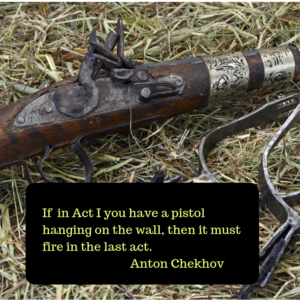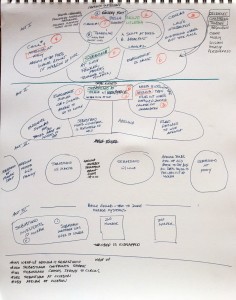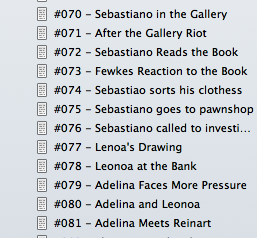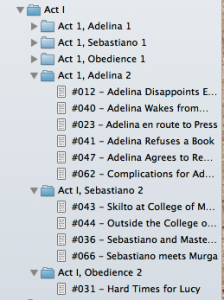
 One of playwright Anton Chekhov’s most quoted maxims is this: If in Act I you have a pistol hanging on the wall, then it must fire in the last act. If you establish an expectation in the reader, particularly a strong expectation, you must fulfill it.
One of playwright Anton Chekhov’s most quoted maxims is this: If in Act I you have a pistol hanging on the wall, then it must fire in the last act. If you establish an expectation in the reader, particularly a strong expectation, you must fulfill it.
The truth is that every story has things in it that must be fired, a multiplicity of tiny guns whose discharges help create the ending, guns that have been primed and loaded over the course of the story.
These are sometimes subplots: the heroine’s best friend is also looking for a love interest and at the end their expectation is either fulfilled or thwarted but it is never neglected, because the reader will exit the story wondering about that, and all the impact of the story will be thwarted.
But not always. They may be an object that is reprised throughout the work: the lily that signals Death’s approach, the clerk who sold a traveler their tickets.
Let’s look at some of this at work in a story that will be familiar to many, James Tiptree’s The Women Men Don’t See. If you are not familiar with the story, I advise reading it beforehand.
This is the ending. My comments appear in parentheses.
By noon we’re back in Cozumel. Captain Estéban accepts his fees and departs laconically for his insurance wars. (Tiptree accounts for this major character and moves him offstage.) I leave the parson’s bags with the Caribe agent who couldn’t care less.(Another character, who appeared toward the beginning, is checked off the list.) The cable foes to a Mrs. Priscilla Hayes Smith, also of Bethesda. I take myself to a medico (the narrator has been injured in the course of the story, an injury severe enough that it shapes the action and therefore must appear in the final moments) and by three P.M. I’m sitting on the Cabanas terrace with a fat leg and a double margarita, trying to believe the whole thing. (Notice that this creates space in which the reader, like the narrator, can think back over the story and draw conclusions.)
The cable said, Althea and I taking extraordinary opportunity for travel. Gone several years. Please take charge our affairs. Love, Ruth.
She’d written it that afternoon, you understand. (The reader has seen this moment, but not what she wrote. Now it’s delivered.)
I another another double, wishing to hell I’d gotten a good look at that gizmo. Did it have a label, Made by Betelgeusians? No matter how weird it was, how could a person be crazy enough to imagine–?
Not only that but to hope, to plan? If I could only go away… That’s what she was doing, all day. Waiting, hoping, figuring how to get Althea. To go sight unseen to an alien world…
With the third margarita I try a joke about alienated women, but my heart’s not in it. And I’m certain there won’t be any bother, any trouble at all. Two human women, one of them possibly pregnant (here a storyline with Captain Estéban is being resolved), have departed for, I guess, the stars; and the fabric of society will never show a ripple. I brood: do all Mrs. Parsons’s friends hold themselves in readiness for any eventuality, including leaving Earth? And will Mrs. Parsons somehow one day contrive to send for Mrs. Priscilla Hays Smith, that grand person?
I can only send for another cold one, musing on Althea. What suns will Estéban’s sloe-eyed offspring, if any, look upon? “Get in, Althea, we’re taking off for Orion.” “A-okay, Mother.” Is that some system of upbringing? We survive by ones and twos in the chinks of your world-machine…I’m used to aliens. (Here a conversation is being reprised, and its payload, set up earlier, is now being delivered.) She’d meant every word. Insane. How could a woman choose to live among unknown monsters, to say good-bye to her home, her world?
As the margaritas take hold, the whole mad scenario melts down to the image of those two small shapes sitting side by side in the receding alien glare.
Two of our opossums are missing.
 The conversation has been loaded here, midway through the story:
The conversation has been loaded here, midway through the story:
“That’s fantasy.” Her voice is still quiet. “Women don’t work that way. We’re a –a toothless world.” She looks around as if she wanted to stop talking. “What women do is survive. We live by ones and twos in the chinks of your world-machine.”
“Sounds like a guerrilla operation.” I’m not really joking, here in the ‘gator den. In fact, I’m wondering if I spent too much thought on mahogany logs.
“Guerrillas have something to hope for.” Suddenly she switches on a jolly smile. “Think of us as oppssums, Don. Did you know there are opossums living all over. Even in New York City.”
How do we emulate that sort of thing as writers? I suspect this is something that most of us will be adding in the rewriting and revision stage, going back through the story to see what pistols our unconscious mind has scattered about throughout the narrative. Recently, for example, in the course of writing a space opera novel, a particular element emerged that shapes things — while I took account of it in writing everything after that moment of realization, I’ll need to go back and tweak the earlier parts to make sure I’ve loaded that object as fully as I can before it delivers its payload in the final scene.
Check what you’ve loaded the story with and make sure it’s all primed and ready to go off.
Enjoy this and want more writing tips and musings on a weekly basis? Follow me on Patreon. Or sign up for a live or on-demand class from The Rambo Academy for Wayward Writers!
...

For the on-demand version, what I’m doing is looking at each of the various ways I’ve seen stories develop and doing a section on each, looking at what it is, what it gives you to help with fleshing out the story, possible trouble spots, some ways to proceed with it, and then two or three exercises to refine skills with that, each with a basic and then an overachiever version, a model I used with the Description and Delivering Information class. There’s twenty-three sections altogether, but here’s the section on starting with a plot, minus the exercises.
What It Is:
Some stories begin with a plot. This is a complete story: you know the problem, some basics of the characters and what will happen. Perhaps it’s something you’ve generated or taken from elsewhere. Perhaps it arrives pre-made in your head (and you should glory in it when it does, in my opinion), so all you need to do is sit down at the keyboard and write it out.
If you can describe in a few sentences what will happen in a story, you know the plot. For example:
What it gives you:
You know the overall flow of the action: this happens so this happens so this happens and then it ends this way. You know the basic story pattern: that tension increases until the climax, and then rapidly falls. You know the source of the tension and usually the basic conflict: how the wants of two or more entities are collide in some fashion.
You have some sense of where it begins and a stronger sense of where it ends (although the reverse is not impossible).”‹ Connie Willis says to begin at the moment when the problem becomes a crisis. I don’t know that I agree that you should always do that, but it’s certainly better, in terms of story tension, to start with a moment where the problem is already taking place than to start with an idyllic landscape that slowly goes bad.
You may or may not know the characters involved, but you have some broad basics, and know some of the things about the character that affect it most for you, which will probably include gender and approximate age.
Similarly you have some broad basics of the setting, the overall world of the story, although you may need to think of specifics pertaining to scene locations.
More importantly, often you have an impalpable feel for the story, a sense of the overall tone and emotion that will help you shape the words as you write. To make the most of that, spend a couple of moments thinking about the atmosphere of the story. What movies or books might you compare it to? What is the overall emotion, both yours in writing it and what you want readers to take away?
What you need to think about:
What do you bring to the story that makes it unique? There are only so many plots (opinions of the actual number differ, with some saying seven, others numbers like 3 or 36, but the fact of the matter is that at a certain level you will not be able to do anything genuinely new unless you are more of a genius than I, and so you should look at what you bring to the table: the unique details of your life and experiences, your emotions and understandings, and your sensibilities. What instances of this plot have you witnessed being played out in your own life, perhaps as actor, perhaps as audience, and what of that experience can you draw upon?
Specifics of the action may be lacking in your broad overview, in which case you will need to flesh them out. Your burglar steals something – what? Who owns it and what defenses against thieves do they have? Your bounty hunter is chasing her prey, but what crime has that prey committed? Specifics of the location are something that you may well need to flesh out, in which case try to think of aspects that are particularly engaging and use those as interesting backgrounds to add interest to a scene: make that important conversation take place while the two are racing on ice skates through a city’s lower levels or at a party whose main entertainment are levitating performers who are half-dragon, half-human. What can you use?
Things to watch out for:
Sometimes when you go to put these stories down on paper, they are not the well-fleshed entities we hoped, but incomplete things, hints of lines that don’t tell us the entire picture, whispers instead of words, a sense of brushing up against one side of the story in the dark rather than holding it in its entirety. In such cases, I usually build a mind-map, writing down the details that I know and expanding from that. I’ll build on how to do that in the next section, Possible Next Steps.
Be careful of the generic. We all have a set of flimsy and unconvincing stage sets in our heads that, when examined with care, can probably be traced back to specific television shows or movies. My desert island will always have Gilligan lurking in the underbrush, for example, and any Victorian London scenes have to be forcibly wrenched out of the black and white of the old Basil Rathbone Sherlock Holmes movies.
Possible next steps:
Take your two or three sentence description and expand on it, stretching it to five hundred words by expanding on generic details with specifics and figuring out the overall timeline.
Write out list of scenes then develop the basics of what happens in each scene: they go to the movies, see a clue in the opening, and try to rush out of the theater only to find a bunch of lamias in the parking lot ready to brawl; they fight with the lamias and defeat them by throwing soap bombs at them, but Ellen’s arm gets broken in the process. You will probably tell it in chronological order, but it’s not too early to think about mixing it up if you think it would accomplish something in the story, like provide additional pleasure for the reader by allowing them to assemble the pieces of the puzzle.
Curious about this class?
...
Yesterday I got very little writing done, and instead worked on plotting. Ugh. I’ve reached that stage of the manuscript where I feel like I’m herding cats, and it seemed like time to make things make more sense.
Major Ingredients for Plotting
In starting, I had the following:
And some things that made the process of plotting more complicated:
Figuring Out the Overall Structure: the Sketchbook Method
So I printed out the synopsis and got out my big sketchpad. I wrote the three chronological points that were most important from the first book on the page, roughly where I thought they’d fall in the book: one at the very beginning, one about a quarter way through, and one about half the way through.
At first I divided the page into three sections for three acts, but by the time I was done, there were five sections total. I think of them as “acts” in that I want them to begin at an interesting point, have the right mix of scenes from the different POVs, and finish in a way that feels like a mini-ending, a chance to think about what’s gone before and to prepare for what’s coming up.

As you can see, that first page eventually ended up looking like a bit of a mess (and right now the image keeps showing up sideways, for some inexplicable reason that I cannot figure out at the moment), but it let me figure out where some things had to happen and realize that I had to nail down where a particular character from the first book is at all times.
I started working with colored pencils in order to track the different main characters, but that fell away as I began arranging what I already had. But it’s handy to be able to see the story from a high altitude, the 10,000 foot view, so to speak, particularly in terms of making the story make sense. Because while the writer can — and probably should deviate from a straightforward chronology for anything but the least complicated of stories — every time they do it, they place a demand on the reader to jump the hurdle and bounce along into the next scene with them.
As far as what’s been written, I have it in Scrivener, that most indispensable of tools. My process lately has been to work on individual scenes in nothing at all like chronological order, but more in the order of ones that really will be fun to write first (this approach has the drawback of inevitably arriving at a final sludge of scenes you didn’t want to write, but you will find at that point that at least half of them are actually not necessary.) So I began splitting up the pieces that were actually multiple scenes crammed in one document because they’d all been part of the same writing sprint, and numbering each one.

Breaking Things Down: Individual Acts
Taking my big sheet, I created a new one for each of the first four sections, and with each, tried to figure out the structure as far as the alternating voices went. I realized that what I had were two main points of view (Adelina and Sebastiano) and then a third one consisting of a brother and a sister (Eloquence and Obedience).
As I went through the manuscript, I began to sort the scenes into order, creating folders for the different POVs. While the scenes may not happen in the exact order they do in the folder, this gets me started putting scenes that will be close together into a single chunk.

Here are the individual act pages. As you can see, they’re messy and inexact, but they’re helping me sort out what goes where in a way that will then let me compile what I have into a document and start looking for the major holes, since filling them in is the next step.
Once I have those holes filled in, I’ll begin wrestling each chunk into a smooth form, and imposing a story arc of one kind or another on it.
Someone asked how I use Tarot cards in plotting. I use them as a way to figure out the major points and considerations for a scene or a chunk, by doing a simple Celtic Cross reading for the main character in that scene. If you’re not familiar with Tarot cards and that configuration for reading them, here’s better information on the spread, and I’ll blog sometime in the next couple days with a sample reading for a scene (but right now I should put in some actual ficiton wordcount).
Some SFWA and Class-related Stuff
In SFWA news, Todd Vandemark has put up the 1st of the videos he filmed at this year’s Nebulas, Steven Gould and I talking about joining SFWA. There will be new content on the channel released on a regular basis throughout the coming year, and I’m pleased to see that idea finally taking solid form.
Maggie Hogarth is onboard as the new Vice President and already hard at work. Look for some cool stuff coming up over the new year. 🙂
Finally, I’ve been doing some teaching from retreat and finding out that the wireless works fine. The Writing Your Way Into Your Novel class was terrific and gave me lots of ideas. This Saturday the 6 week Writing F&SF Stories starts. I’ve still got slots in that (as well as most of the other classes) and would be willing to talk about sliding scale or barter if you’re interested. If you’re interested, check out the list of classes here.
...

The story I just finished, whose working title is “Villa Encantada,” is one whose beginning I wrote over a year ago. I picked it up last summer and added a couple of scenes, but something about it has felt wrong and it’s been just lumpy scenes stuffed full of description of a balcony garden. I was pretty sure it didn’t begin where it was supposed to, and also pretty sure that the best thing to do would be to start it again from scratch, write it, then mine the previous efforts to see what should get folded into it.
So when I read this post on plotting out stories, I decided to use it to plot out mine. All you do, according to the oridinal webpage, is complete the sentences. I’ve thought about the story and its theme and know it about halfway well enough, I think.
1. Once upon a time . . . there was a woman who could not forgive herself.
2. Every day . . . she tried to kill herself in the very smallest of ways, cigarettes and high heels on stairways.
3. Until this . . . she meets a new neighbor, who is bossy and ominous and presumptuous.
4. Because of this . . . she tries to make friends and allies in the rest of the apartment complex.
5. Because of this . . . The bitchy neighbor, who is a witch, attacks her in increasingly powerful ways, leading up to a third neighbor’s death.
6. Until finally . . . the protagonist is pissed off enough to stop feeling guilty and react in a way that saves herself.
7. For every day . . . I’m not sure what to do with this last, but I’ll wrap the story up with some gesture that shows that her forgiveness of herself is a lasting and life-changing thing.
Okay. That let me start thinking about it in terms of scenes, once I had the overall arc in my head. From there I did start from scratch and write the story from my head. In the process I found myself adding a frame story. Once I finally had that draft I could go through the first version and fold in passages that I wanted to keep. I’m still not happy with the end, but at least I have a complete story now that I can tinker with.
...
Want access to a lively community of writers and readers, free writing classes, co-working sessions, special speakers, weekly writing games, random pictures and MORE for as little as $2? Check out Cat’s Patreon campaign.

"(On the writing F&SF workshop) Wanted to crow and say thanks: the first story I wrote after taking your class was my very first sale. Coincidence? nah….thanks so much."

(Fiction, short story) The thing is, I was never a hero. The first wave of aliens taught me that. The war with them – my older brothers became heroes there, one died in the stand-off at Ucer-25, and we never did discover what happened to the other. My parents celebrated them both, burned scarlet and gold candles that made the house smell like flaming trees and sulphur, every weekend without fail…


This site is protected by reCAPTCHA and the Google Privacy Policy and Terms of Service apply. This site is a participant in the Amazon Services LLC Associates Program, an affiliate advertising program designed to provide a means for sites to earn advertising fees by advertising and linking to Amazon.com.